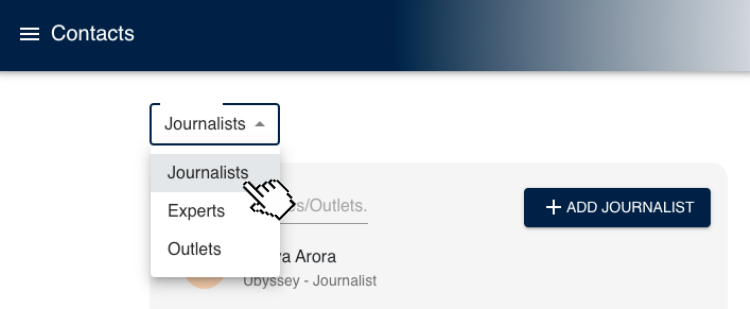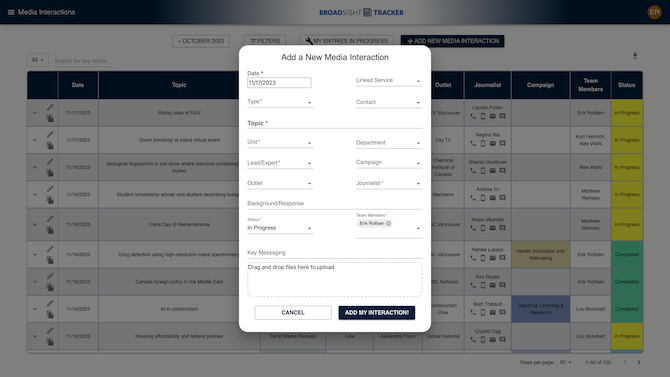How to Build a Media List That Will Actually Respond
Building a media list is easy. Many software tools will do it for you.
Building a media list that will actually respond to your pitches is harder. It takes time and consistency—and the right tools.
Most PR tools include a database of journalists you can contact when you’re ready to do some targeted pitching. However, the ‘leads’ they provide are cold leads. The journalists usually haven’t heard of you, and they’re unlikely to respond.

Warm leads make all the difference when you have a new story to pitch.
So let’s talk about how to build a media list full of warm leads that will get you results.
Warm Leads Trump Cold Outreach
Any digital marketer can tell you about funnel marketing. Marketers categorize their prospects into cold, warm, and hot based on their likelihood to make a purchase.
Media relations can be viewed through a similar lens when pitching stories to journalists. At the top of this “media relations funnel” are the cold contacts: journalists whom you’ve never approached and who are unaware of your organization or its story.
You’ll come across a lot of these if you use a general PR database to build your media list. Pitching to these journalists requires significant groundwork and a compelling angle to pique their interest. It’s similar to how a marketer might approach a potential customer who is unfamiliar with their product.
Moving down the funnel, we have warm contacts: journalists you’ve previously pitched, or who have covered your stories and have some familiarity with your organization and brand. With these journalists, you have at least a preliminary level of trust and rapport. Their receptiveness to new pitches is higher, just as a warm lead in marketing might be more open to a sales conversation.
Finally, at the narrowest part of the funnel are the hot contacts: journalists with whom you have a well-established relationship. They’ve consistently covered stories, have direct communication channels open, and often see the mutual benefit in the relationship. These journalists are to PR what ready-to-buy customers are to marketers. Build media lists full of these folks, and you’ll have a much higher ‘conversion rate’ (in terms of story coverage). The interaction is also typically more collaborative.

In both funnel marketing and media relations, nurturing relationships is key. The objective is to guide contacts from one level to the next, fostering trust and increasing the likelihood of positive outcomes.
How to Build Your Media List with Broadsight Tracker
You want to build a media list with thousands of contacts, who ideally are warm or hot. This is where putting in the work to build your media list over time really pays off.
At the University of British Columbia, we have been using Broadsight to record every incoming media request since 2019. That’s almost 8,000 media requests. This gives us a huge database of journalist contacts.
Of course, Broadsight Tracker isn’t the only PR tool with a huge database of journalist contacts. Most of them have that.
But Broadsight Tracker is the only one with OUR journalist contacts. It’s a custom database tailored specifically for our media relations team.

At a minimum, we collect the name, phone number, email address and outlet of every journalist who gets in touch, along with the topic they’re working on. Every journalist in our database has covered our news in the past, and we know exactly which topics they were interested in. Doing this consistently with reactive media inquiries has given us a significant leg up when it’s time for proactive outreach.
An example
We have gambling researchers at our university. Gambling is often in the news; perhaps a sports league is expanding betting on its games, or the local government is changing its gambling policy. Media call us looking for experts who can comment. We connect them with our gambling researchers.
A year or so down the road, one of our gambling researchers might be publishing interesting research in an academic journal. It’s our job to try to get media coverage for the findings.
We go to Broadsight and do a topic search for ‘gambling.’ This brings up every journalist who has contacted us in recent years about problem gambling, sports gambling, gambling addiction, etc.
We now have some obvious targets for pitching our research story.
Think about the odds of success. Would we be more likely to get a bite by plugging the word ‘gambling’ into a generic PR database and bringing up a list of somewhat random journalists who just happen to have mentioned gambling in past stories? Or would we do better with folks who have reached out for our help several times in the past year—and have written stories about gambling?
I always have more luck with the latter. I bet you will, too.
Keys to Building Your Media List
To get the most out of your tracker, you have to build a habit.
Log Every Interaction
When things get busy and you’re running around, it’s easy to put off logging media enquiries. Don’t do this. It only takes a minute, and the investment will pay off in a wealth of data to draw on down the road.

Get All The Information
Contact information is obvious, but the topic description is also really important. The more thorough and detailed you can be, the easier it will be to find these journalists later when you need them, by simply typing a keyword or two.
Be Patient
For your first year or so on Broadsight, you won’t have much data. When you plug in a topic, it might not bring up many names. Remember though, you’re playing the long game here. Stick with it and be consistent. With your whole team contributing, over time your contacts database will grow and become much more useful for pitching.
How to Find Journalists to Pitch, Step by Step
Here’s our process for building a pitch list using Broadsight:
- Go to the Media Interactions page
- Click on the ‘Filters’ button at the top of the page
- Enter a keyword in the ‘Topic’ field
- Click ‘Search’

Any interactions that reference your topic should come up. If you click the icons under the journalists’ names, you can copy their phone numbers and email addresses in one click.
Alternatively, you can click the arrow in the top right corner of the page to export all the entries as a CSV file. The CSV will contain the journalists’ names but not their contact info. You can create new columns and copy/paste the contact info using the clickable icons in the table.
Repeat this search process for related or synonymous terms to make sure you capture every media interaction you’ve had.
The Best Media List is The One You Own
The bottom line is that you will have more success in your pitching if you can pitch journalists who:
- are familiar with your organization
- have covered your stories
- have benefited from your help
- have covered the topic you’re pitching
You won’t find many of these journalists using a general PR database, but Broadsight Tracker makes it easy for you to build your own list of warm and hot leads.
Receive our newsletter
Sign up below and we’ll be in touch with monthly updates about Broadsight Tracker, along with news and insights to keep you on the cutting edge of communications work in an AI era.